#canvas paintings for bedroom
Explore tagged Tumblr posts
Text
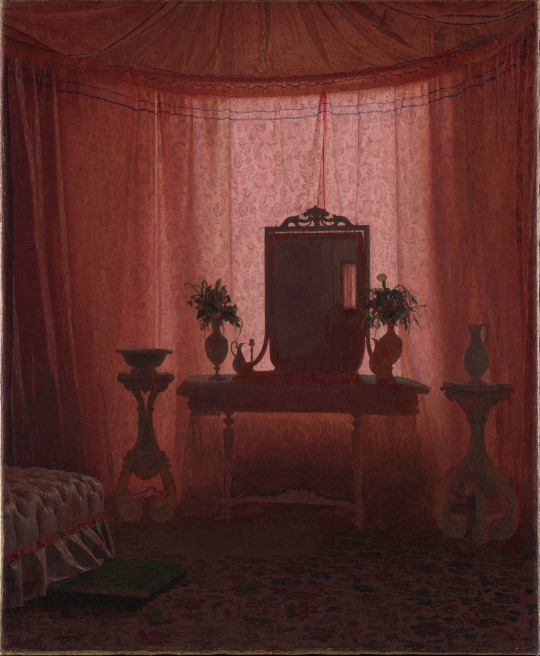
Johan Vilhelm Gertner (Danish), A Bedroom in Bernstorff Palace near Copenhagen, c. 1845, oil on canvas.
#johan vilhelm gertner#Bernstorff Palace#19th century#painting#19th century art#interior#copenhagen#danish art#interior design#period design#nineteenth century interior#art#artwork#oil painting#bedroom#danish design#textiles#design#decor#period decor#architecture#decorative arts#oil on canvas#danish artist#christian viii#denmark#pink#fave#art history#design history
483 notes
·
View notes
Text
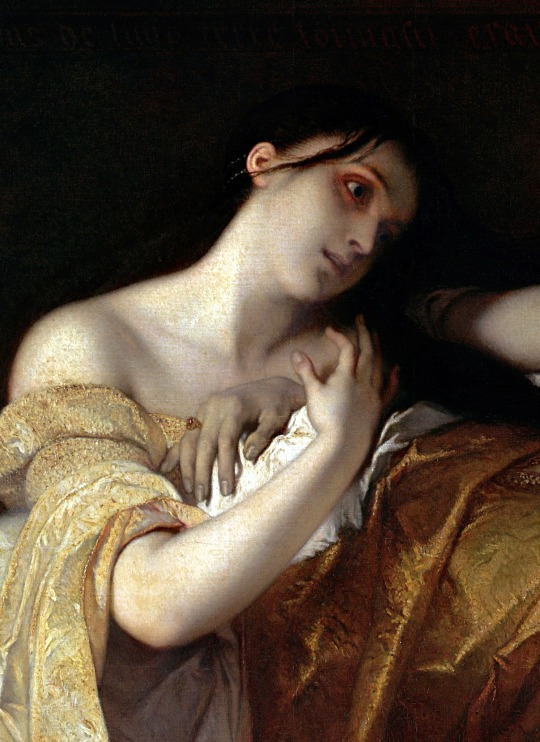
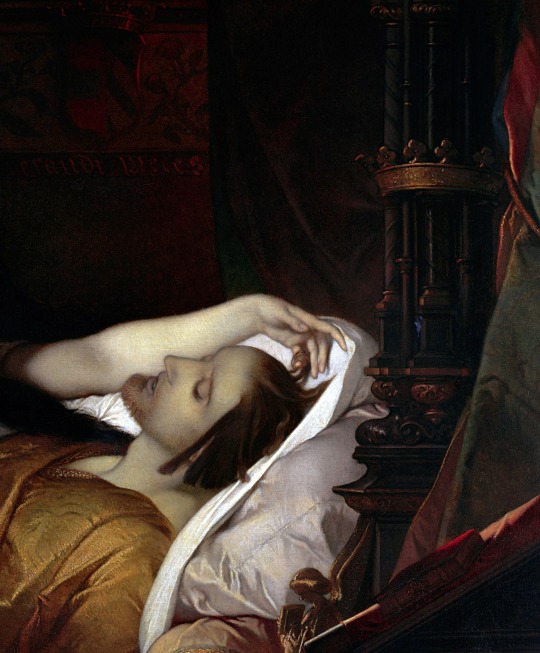
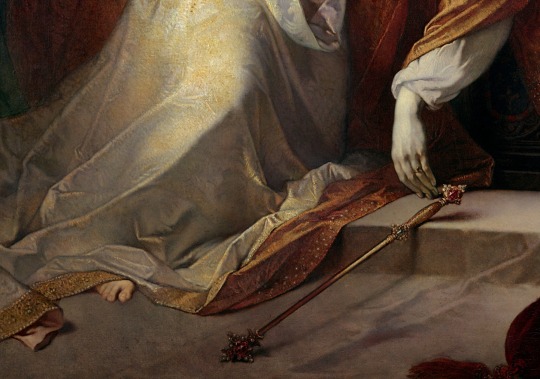
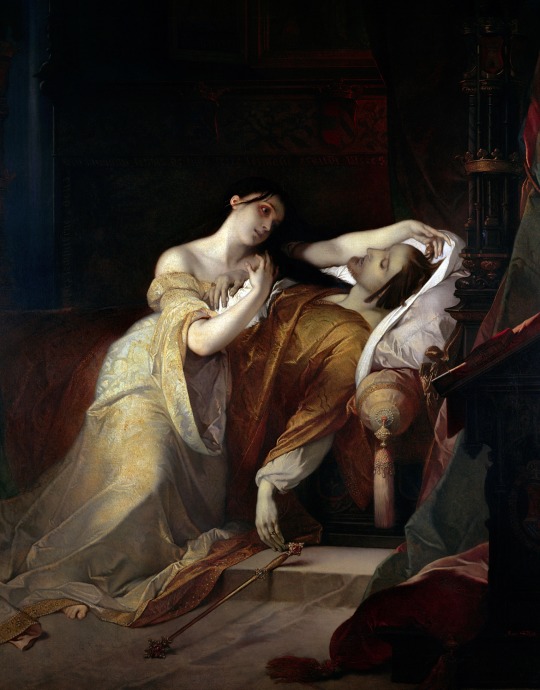
Joanna the Mad with Philip I the Handsome (1856) Oil on canvas. — Louis Gallait (Belgian, 1810-1887)
#Louis Gallait#art#paintings#classical art#oil painting#art details#hands#fabric#interior#room#bedroom#sickness#agony#crown#classic art#oil on canvas#art classics#Juana I de Castilla#juana la loca#art history#romanticism
1K notes
·
View notes
Text

The Death of Dante
Artist: Eugenio Moretti Larese (Italian, 1823-1874)
Date: 1852-1853
Medium: Oil on canvas
Collection: Luigi Bailo Museum, Treviso, Italy
The Death of Dante Alighieri 14th September 1321
“Dante and Shakespeare divide the world between them, there is no third.” So said T.S. Eliot. Dante is undoubtedly one of the finest writers that ever walked the earth but it is the afterlife for which he is better known. His work “The Divine Comedy” is a classic of literature. It is an allegory about his walk through the three stages of the Christian afterlife – Hell, Purgatory and Heaven. It is written in the first person as a warning to politicians and others about corruption, set in 1300 and written in vernacular Italian rather than what was more usual at the time - Greek or Latin.
Born in Florence in 1265 to low aristocratic parents, but not wealthy ones, Durante, as he was fully called (Dante is a nickname) lost his mother when he was two. At school he was taught rhetoric, grammar, philosophy, literature and theology. He went on to study Tuscan poetry, painting and music. He was particularly struck with Homer, Virgil and Cicero. By the age of 12 his marriage was arranged to Gemma di Manetto Donati and they were to have three, possibly four, children, it is not known for certain. Dante though had already fallen in love with a girl called Beatrice Portinari. He claimed that this was love at first sight but was to remain unrequited; a courtly love. Beatrice died in 1290 and Dante never fully got over it. After her death he wrote a poem entitled “La Vita Nouvo” or the New Life. Also written in Italian this spoke of courtly love which Dante saw as the ideal and he centred his work not on himself but on his interpretation of love.
Dante worked his way up through the political system and became a Priore, which was a little like a governor. However, as usual in Italian cities, and Florence in particular, there were a lot of political machinations. There were two distinct groups fighting for power – the Guelphs and the Ghibellines. Dante was on the side of the former who won this particular struggle. However the Guelphs were to split between the White Guelphs and the Black Guelphs. Again Dante was on the side of the former who took control. They were more sceptical of the motives of the Pope, Boniface VIII, and went to Rome to seek out his intentions. Whilst they were there the Black Guelphs seized Florence and destroyed much of it. Dante was never to return to his own City. He was banned for life.
Much of the writing for the Divine Comedy was undertaken in Ravenna. The work tells of his own path to salvation and offers moral and philosophical judgements along the way. Each of the three sections, Hell (Inferno), Purgatory (Purgatorio) and Heaven (Paradiso) has nine further subsections with a tenth as a top, final stage. In Hell this is where Lucifer himself dwells. In this section Satan is up to his waist in ice and chewing on the three greatest sinners - Judas, Brutus and Cassius. The ninth stage is reserved for treacherous people who are buried up to their necks in the same ice. On his journey Dante speaks to various sinners at different levels.
In his journeys through Hell and Purgatory his guide is the Roman poet, Virgil. Once inside Purgatorio he climbs the Mount of Purgatory that has the first seven levels (One for each of the seven deadly sins). Eventually he reaches the top level, the Garden of Eden, where he must learn to reject earthly paradise for the heavenly one that awaits.
At this stage Virgil leaves him and the love of his life Beatrice takes him through the final stage of Heaven, or Paradiso. On his way up he meets Thomas Aquinas and King Solomon before reaching the top level symbolised by three rings for the Holy Trinity - The Father, the Son and the Holy Spirit - where he meets God himself.
Dante died in 1321 and was buried in Ravenna. Florence regretted exiling one of the finest and foremost writers of any generation and asked for his body to be returned. Officials in Ravenna refused and were so worried that his remains might be stolen they hid them between the walls of a monastery. Nevertheless Florence had a tomb built for him in 1829 in the basilica of Santa Croce and it remains empty to this day. The words on it read: “Onorate l'altissimo poeta” which translate as, honour the most exalted poet.
Many of Dante’s phrases are household expressions today. “The darkest places in hell are reserved for those who maintain their neutrality in times of moral crisis.” “The secret of getting things done is to act” and “All hope abandon, ye who enter here.”
One of the most telling quotes, I believe, is “Consider your origins. You were not made to live as brutes, but to follow virtue and knowledge.” Perhaps this is a message that is as relevant to world leaders today as it was to those in the fourteenth century.
Biography
#the death of dante#interior scene#bedroom#bed#dante#painting#fine art#oil on canvas#artwork#dante alighieri#italian writer#italian poet#italian philosopher#literature#men#eugenio moretti#italian painter#italian art#italian history#19th century painting#european art#art
28 notes
·
View notes
Text

The Lady Betty Germain Bedroom at Knole, Kent
Artist: James Holland (English, 1799–1870)
Date: 1845
Medium: Oil on canvas
Collection: Yale Center for British Art, New Haven, CT, United States
#bedroom#indoor scene#lady betty germain#kent#england#english culture#painting#oil on canvas#james holland#english painter#book#women#candles#chairs#costume#curtains#door#fireplace#genre subject#house#interior#genre art#mirrors#paintings#reading#room#oil painting#fine art#european art#english art
23 notes
·
View notes
Photo

Valeria Duca, “Grandma`s Socks”, 2020, oil on canvas. B. 1995, Moldovan by birth, residence at Washington DC.
#valeria duca#Grandma`s Socks#2020#oil on canvas#moldovan artist#oil painting#painting#art#woman#portrait#red#socks#bed#bedroom#figurative art#contemporary art#moldovan art
20 notes
·
View notes
Text

The Bedroom (1888) 🎨 Vincent van Gogh 🏛️ The Art Institute of Chicago 📍 Chicago, United States
Vincent van Gogh so highly esteemed his bedroom painting that he made three distinct versions: the first, now in the collection of the Van Gogh Museum, Amsterdam; the second, belonging to the Art Institute of Chicago, painted a year later on the same scale and almost identical; and a third, smaller canvas in the collection of the Musée d’Orsay, Paris, which he made as a gift for his mother and sister. Van Gogh conceived the first Bedroom in October 1888, a month after he moved into his “Yellow House” in Arles, France. This moment marked the first time the artist had a home of his own, and he had immediately and enthusiastically set about decorating, painting a suite of canvases to fill the walls. Completely exhausted from the effort, he spent two-and-a-half days in bed and was then inspired to create a painting of his bedroom. As he wrote to his brother Theo, “It amused me enormously doing this bare interior. With a simplicity à la Seurat. In flat tints, but coarsely brushed in full impasto, the walls pale lilac, the floor in a broken and faded red, the chairs and the bed chrome yellow, the pillows and the sheet very pale lemon green, the bedspread blood-red, the dressing-table orange, the washbasin blue, the window green. I had wished to express utter repose with all these very different tones.” Although the picture symbolized relaxation and peace to the artist, to our eyes the canvas seems to teem with nervous energy, instability, and turmoil, an effect heightened by the sharply receding perspective.
#The Bedroom#1888#Vincent van Gogh#The Art Institute of Chicago#Chicago#United States#oil painting#painting#oil on canvas#Modern art#Post-Impressionism#art#artwork#art history#dutch
35 notes
·
View notes
Text

STARRY BOUQUET
#van gogh#starry night#vincent van gogh#1889#19th century art#19th century#moma#museum of modern art#oil on canvas#oil painting#Nocturne#paul gauguin#paul cezanne#claude monet#monet#arles#bedroom in arles#Vincent#sunflowers#post impressionism#painting#art history#van gogh museum#amsterdam#dutch artist#tortured artist#modern art#bouquet#flowers#ikebana
39 notes
·
View notes
Text

Self-Portrait
Artist: Hilda Carline (British, 1889–1950)
Date: 1923
Medium: OIl paint on canvas
Collection: TATE Britain
Description
The 1920s saw a revival in portraiture, and a belief in the importance of self-realisation influenced by modern psychology. The First World War had increased the numbers of women in the workforce, and in 1918 the vote was extended to many women. Carline had served in the Women’s Land Army during the war and the directness of her gaze is suggestive of the increased independence of the modern woman of the inter-war period. Carline trained with the post-impressionist painter Percyval Tudor-Hart and at the Slade School of Fine Art, where her brothers Sydney and Richard also studied.
Biography
Hilda Anne Carline (1889–1950) was a British painter, daughter of the artist George Francis Carline, and first wife of the artist Stanley Spencer. She studied art under the Post-Impressionist Percyval Tudor-Hart, with her brothers Sydney and Richard, and then at the Slade School of Art under Henry Tonks. She had a promising early start with her works being shown at the London Group, Royal Academy and New English Art Club.
In 1925 she married fellow artist Stanley Spencer with whom she had what has been described as "the most bizarre domestic soap opera in the history of British art." During the time that Carline lived with Spencer she rarely painted and it was not until they separated that she began painting more frequently. Carline's physical and mental health was poor starting several years after her divorce and after 1937 she lived with family members. Spencer became obsessed with his ex-wife with whom he corresponded and painted. In her later years she made religious works with pastels. She died in 1950, having struggled for several years with breast cancer. A touring exhibition of her works, The Art of Hilda Carline: Mrs. Stanley Spencer, was held in 1999.
#portrait#fine art#oil painting#woman#interior scene#three quarter length#bedroom#bed#artwork#lamp#textiles#standing#blue sweater#necklace#brimmed hat#hilda carline#british painter#british culture#oil on canvas#european art#20th century painting#20th century art#1923
15 notes
·
View notes
Text

Joseph Accused by Potiphar's Wife
Artist: Rembrandt van Rijn (related artist) Dutch, 1606 - 1669)
Date: 1655
Medium: Oil on Canvas
Collection: The National Gallery, Washington, DC, United States
Description
After learning the fundamentals of drawing and painting in his native Leiden, Rembrandt van Rijn went to Amsterdam in 1624 to study for six months with Pieter Lastman (1583–1633), a famous history painter. Upon completion of his training Rembrandt returned to Leiden. Around 1632 he moved to Amsterdam, quickly establishing himself as the town’s leading artist, specializing in history paintings and portraiture. He received many commissions and attracted a number of students who came to learn his method of painting.
In the seventeenth century, history painting - the depiction of biblical, mythological, and allegorical scenes - was considered the pinnacle of artistic expression. Because such paintings required great imagination and dealt with fundamental moral and ethical issues, theorists ranked history painting before other subjects such as landscape, portraiture, and still life.
The story of Joseph fascinated Rembrandt, who made numerous drawings, prints, and paintings of this Old Testament figure. This particular work, however, was executed by one of Rembrandt’s workshop assistants after the master himself had determined the subject matter and composition. In this scene from the book of Genesis, chapter 39, Potiphar's wife, having failed to seduce Joseph, falsely accuses him of trying to violate her. Speaking to Potiphar, the wife points to the red robe Joseph left behind when he ran from her clutches, wickedly using the presence of the garment as evidence to support her accusation. In the biblical account, Joseph was not present, but the artist added poignancy to his visualization of the story by inserting Joseph on the far side of the bed. Rembrandt’s preoccupation with the theme of false accusation probably stemmed from the drawn-out lawsuit against him by Geertje Dirckx, a former companion, who claimed that he had promised to marry her.
#painting#christian art#woman#joseph#bedroom#potiphar#christianity#egypt#old testament#rembrandt van rjin#dutch art#bed#textiles#biblical scene#holy bible#17th century#oil on canvas#book of genesis#red robe
10 notes
·
View notes
Text

love being able to put a painting up here to see it in a new context when I’m done <3
first finished painting this year
#it’s been tough#art#painting#artists on tumblr#traditional art#oil painting#contemporary art#fine art#studyblr#oil on canvas#bedroom#aesthetic home#home decor#bed#plants#eclectic maximalism#support human artists#trad artist#artist support#artists on patreon#cozycore#cozy aesthetic#cozy vibes
13 notes
·
View notes
Text

Antiochus Yearning for Stratonice
Artist: Stefano Pozzi (Italian, 1699–1768)
Date: c. 1740
Medium: Oil on Canvas
Collection: Art Institute of Chicago, Chicago, IL, United States
Description
Struck by a mysterious illness, Antiochus lies in bed near death. His grieving father, who has recently taken Stratonice as his wife, summons a doctor. Noticing that the sight of the young woman quickens Antiochus’ pulse and that passion causes his sickness, the doctor describes the youth’s predicament to his father, who selflessly offers Stratonice to his son. The subject, both a love story and an example of parental devotion, enjoyed considerable popularity well into the 1800s.
#mythological painting#antiochus#sickness#bedridden#interior#bedroom#male figure#mythological scene#love#yearning#stratonice#passion#love story#parental devotion#fine art#stefano pozzi#italian painter#italian culture#arwork#oil on canvas#mythology#18th century painting#european art#art institute of chicago
5 notes
·
View notes
Text

Allegory on the Death of the Dauphin
Artist: Louis-Jean-François Lagrenée (French, 1725–1805)
Date: 1765
Medium: Oil on Canvas
Collection: Musée National du Château, Fontainebleau
Description
Legranée received several royal commissions in a busy life. In the Allegory on the Death of the Dauphin the figures are not strictly allegorical, apart from the sorrowing France behind the bed, for they represent the dauphine and the couple's sons (including the dead one who appears with a crown of stars for his dying father), the effect is of allegory rather than fact. And the idiom in which the picture is painted is certainly classical, much as interpreted by Batoni, though critics of the day it suggested Guido Reni.
#painting#oil on canvas#death of the dauphin#jean francois legrenee#french painter#allegory of death#bedroom#bed#sorrowing france#male figure#female figure#rays of light#cloud#crown of stars#costume#textiles#maps#book#drapes#european art#18th century painting
4 notes
·
View notes
Text

Pamela Fainting
Artist: Joseph Highmore (English, 1692-1780) rococo
Date: 1743-1744
Medium: Oil on canvas
Collection: National Gallery of Victoria, Melbourne, Australia
Description
In 1743–44 Joseph Highmore created twelve paintings based on Samuel Richardson’s popular novel Pamela (1740–41). These paintings are now divided equally between the Tate Gallery, London, the Fitzwilliam Museum, Cambridge and the National Gallery of Victoria. Pamela tells the story of a maidservant, Pamela Andrews, who resisted the lustful attempts of her young master, Squire B., to seduce her (as seen here). She eventually converts him to goodness, and her virtue is rewarded by a marriage above her status.
#literary art#english literature#samuel richardson's pamela#english writer#interior#literary scene#oil on canvas#rococo style#artwork#fine art#oil painting#bedroom#bed#pamela#man#women#costume#curtains#table#textiles#english culture#english art#joseph highmore#english painter#european art#18th century painting#natural gallery of victoria
11 notes
·
View notes
Text

Interior of the Bedroom of the Chateau du Breau
Artist: Walter Gay (American, 1856-1937)
Date: c. 1912
Medium: Oil on canvas
Collection: Pennsylvania Academy of the Fine Arts, Philadelphia, PA, United States
#interior#painting#bedroom#artwork#still life#bed#dresser#fireplace#chair#canopy#doors#drapery#oil on canvas#fine art#oil painting#american art#american culture#france#walter gay#american painter#20th century painting#pennsylvania academy of the fine arts
16 notes
·
View notes
Text

New painting, rebirth 04
For sale, shop here ✨
#butterfly#golden hour#framed art#framed print#sunset#room decor#bedroom artwork#painting#paint on canvas#traditional artist#acrylic painting#artist
5 notes
·
View notes
Text
I wanna build Lego so BAD....
#my dream since forever is that lego kit like it's like a building in a city#and it has a restaurant and on the top floor a small bedroom#where a lego artist paints and has their own little lego piece canvas...#and u can rearrange the pieces to make new artwork#and in the restaurant one of the figurines is a lego with his gf and he's holding a wedding ring#i would watch the same vid of someone speed building it every day#ONE DAY...!#one day ill have it
2 notes
·
View notes